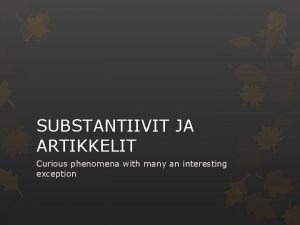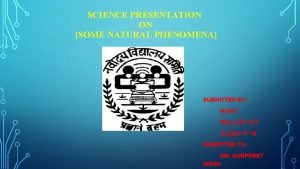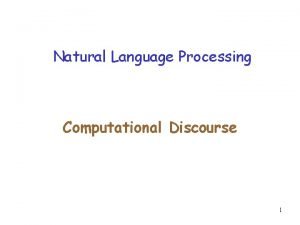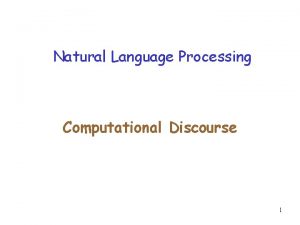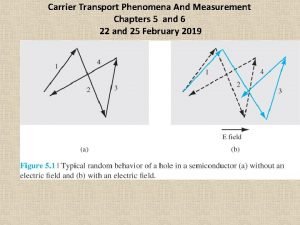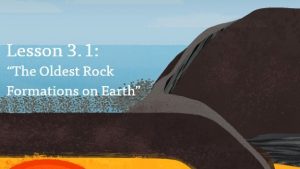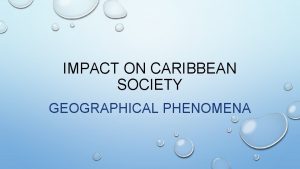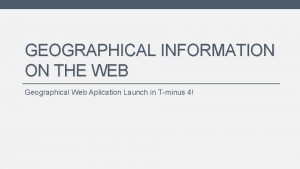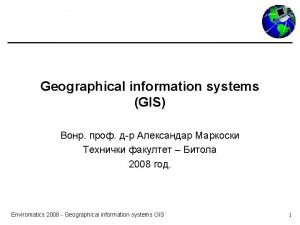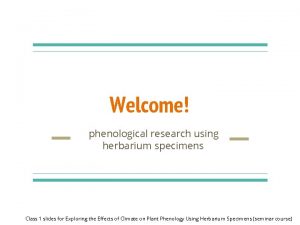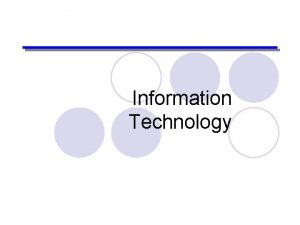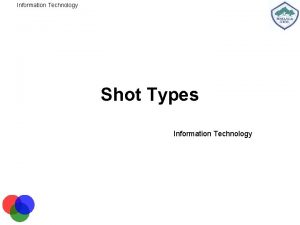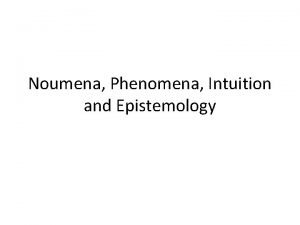Using Geographical Information Technology to capture phenological phenomena
















- Slides: 16

Using Geographical Information Technology to capture phenological phenomena in European schools The Phenolo. GIT project Andrew Edwards-Jones, Plymouth Institute of Education, Plymouth University

Project Partners CPI O Cruce

Project Aim Phenolo. GIT will design, build and test a collaboratively created educational environmental information platform, supported by state-of-the-art mobile technology and Geographical Information Technologies (GIT), to be used by teachers and students in primary and secondary schools. https: //www. phenologit. org/

What is Phenology? Phenology is the study of the timing of recurring biological events in the animal and plant world, the causes of their timing with regard to biotic and abiotic forces, and the interrelation among phases of the same or different species (Lieth, 1974). Lieth, H. (1974) Phenology and seasonality modeling. Ecol. Stud. 8. New York: Springer-Verlag.

Project Outputs • Needs Analysis and Best Practice review: GIT, mobiles and phenology in European Schools: state of the art (CITE) • Educational Methodology for piloting GIT in schools and developing online platform (VIA) • Development of Phenolo. GIT technical solution (CESGA) • Development of GIT open educational resources (O Cruce) • Pilot Phenolo. GIT (Plymouth University)

Needs Analysis Key Findings Nature (How is phenology seen as a relevant study for curricular activities? ) • Phenology is relevant to teaching all life and physical sciences, particularly biology, geology, ecology and geography • Specific curriculum areas with links to phenology include: Ø climate change Ø plant reproduction and life cycles Ø monitoring grounds to measure seasonal changes Ø impact of seasonal change on biological processes Technology (How are GIT and mobile technologies used in science lessons? ) • 56% of teachers in partner countries have experience of using Geographical Information Technology in school education i. e. Google Earth, Arc. GIS • Mostly used for discreet projects, not integrated into programmes • Data recording i. e. Nature’s Calendar; Feno. Dato • Mobile devices - mostly smart phones with GIS/GIT apps Pedagogy (How does the Phenolo. GIT ethos fit into personal teaching philosophies? ) • Majority of teachers in partner countries are familiar with phenology and would be confident to teach it • No connection between use of GIT and country, teacher age, length of experience or subject specialism - it’s personal! • Majority of teachers believe that GIT could be useful • Phenolo. GIT will motivate and encourage pupils to work

Educational Methodology for piloting GIT in schools and developing online platform (VIA) Key arguments • Makes science interesting, and motivational for students • Aids collaborative learning • Includes ‘hands-on’ and ‘minds-on’ activities • Inquiry-based teaching • Citizen science • Cross curricular Understand ‘big ideas’ in science – such as adaptation, evolution, climate change

Pilot Species criteria : Common to all countries Show seasonal change Of interest to children Scientific merit Taxonomic variety Final selection: Horse chestnut Oak Bramble Daisy Red dead-nettle Dandelion Creeping buttercup Garden (cross) spider 7 Spot Ladybird Common brimstone European peacock Common frog Swallow

Development of Phenolo. GIT technical solution (CESGA) Development of Phenolo. GIT app Development of Map Server Project teachers given access to the App under development and asked to familiarise themselves with functionality and consider how they would use it with their classes.

Interactive map

Development of GIT open educational resources (O Cruce) • Agreed that all partners produce two exemplar teaching activities, using common template incorporating: • Big Idea • Curriculum Links • Learning Objectives • Learning Outcomes • Preparation and Equipment • Activity • Open educational resources repository

Pilot Phenolo. GIT (Plymouth University) • Piloting in Schools • 16 European schools • Key Stages 2 and 3 • 2 phases to pilot • Autumn 2016 – teachers trial and evaluate activities and app • April-July 2017 – students’ activities to observe and gather data

Evaluation • PU will collect copies of evaluations and other data from partners. • These will be collated and common themes identified. • A report will be produced to include: examples of activities, pedagogic approaches, curricular links (link back to IOs 1&2) • Examples of best practice to be published on website and made available for platform.

These tools and resources and the platform from which they are launched will be released as open source tools with free licenses to promote use and development of Phenolo. GIT in the years ahead by an increasing number of schools across Europe.

Impact On teachers: • Needs analysis, raising awareness of phenology and ICT in KS 2/3 curriculum. • Involvement in a research project has featured on some schools’ improvement plans. On other stakeholders: • Stats and social media metrics indicate wide public interest. www. phenpologit. org has had over 5, 400 visits; 41 posts on FB and Twitter accounts, with estimated 7, 200 visits. • Pheno app technology has attracted interest from other developers.

Thankyou for listening! Contacts Project Lead: Prof Linda La Velle, Plymouth Institute of Education: linda. lavelle@plymouth. ac. uk Project Administrator: Joanna Watt: joanna. watt@plymouth. ac. uk
 An aircraft monikko
An aircraft monikko Class 8 some natural phenomena ppt
Class 8 some natural phenomena ppt Physical and chemical phenomena
Physical and chemical phenomena Phenomena related to refraction of light
Phenomena related to refraction of light Observable phenomena
Observable phenomena Objective consideration of contemporary phenomena
Objective consideration of contemporary phenomena Reference phenomena in nlp
Reference phenomena in nlp Reference phenomena in nlp
Reference phenomena in nlp Which are not purely surface phenomena
Which are not purely surface phenomena Gravitation is a natural phenomenon where
Gravitation is a natural phenomenon where Carrier transport phenomena
Carrier transport phenomena Anchor phenomenon
Anchor phenomenon Observable phenomena meaning
Observable phenomena meaning Surface and interfacial phenomena
Surface and interfacial phenomena Reoulox phenomena
Reoulox phenomena Global climate phenomena
Global climate phenomena Random phenomena
Random phenomena
